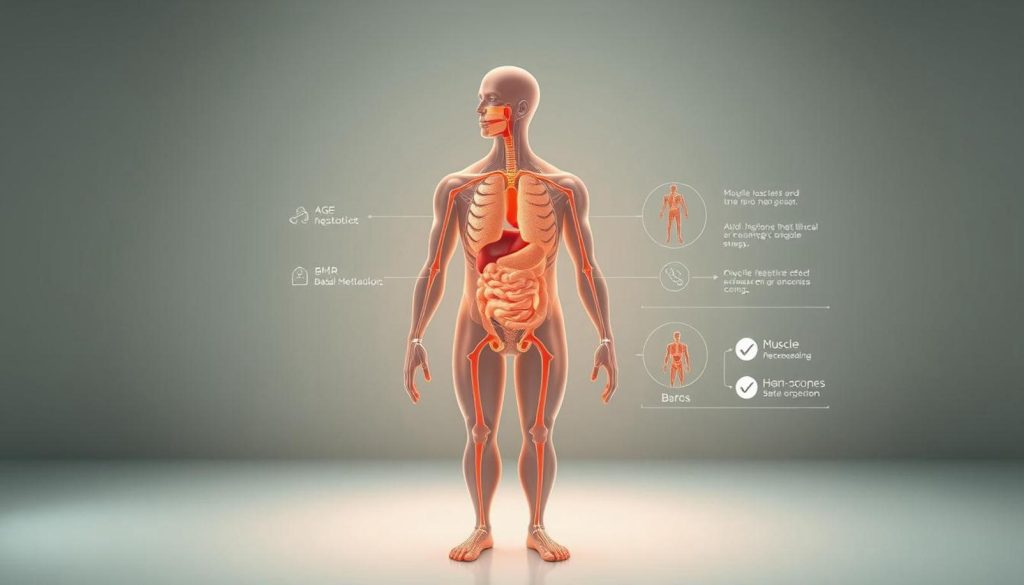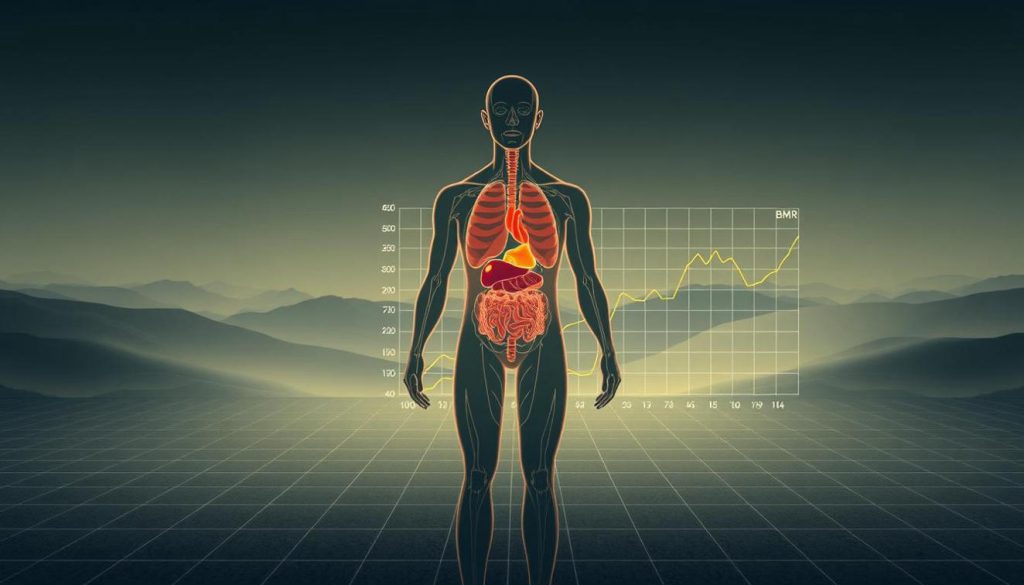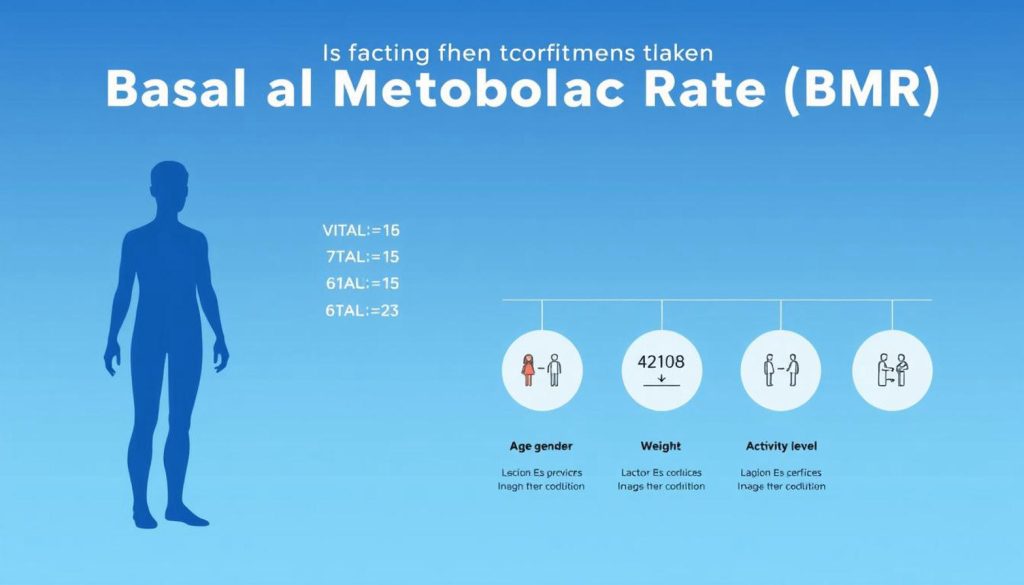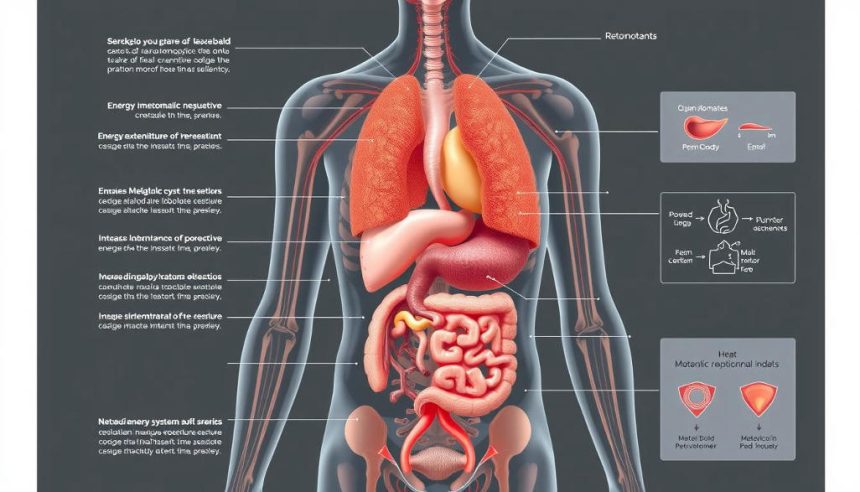Basal Metabolic Rate The cause is their basal metabolic rate (BMR). Our BMR is the number of calories our body requires for operation at rest. It’s instrumental in determining our daily caloric requirements.
Basal Metabolic Rate
Basal Metabolic Rate: What You Should Know
Have you ever wondered why some individuals are able to eat a great deal and not gain weight? Others gain weight very quickly. The cause is their basal metabolic rate (BMR). Our BMR is the number of calories our body requires for operation at rest. It’s instrumental in determining our daily caloric requirements.
If we know our BMR, it is essential for maintaining our weight and well-being. It informs us about the number of calories we should consume to remain the same weight, gain, or lose. With knowledge of our BMR, we can make healthier decisions regarding our diet and physical fitness.
Read More: What Foods Speed Up Female Metabolism

Key Takeaways
BMR is the amount of calories your body requires to operate when you are resting.
If you know your BMR, it is significant for weight management.
BMR influences your caloric needs on a daily basis.
Knowing your BMR enables you to make the best decisions regarding your diet and exercise.
Maintaining a healthy lifestyle can serve to maximize your BMR.
What Is Basal Metabolic Rate and Why It Matters
Basal Metabolic Rate plays an important role in understanding our daily caloric requirements and energy output. It reflects the number of calories our body requires when we are resting.
Definition and Basic Concepts
Basal Metabolic Rate (BMR) is the energy we expend while sitting still. It accounts for the energy required for basic activities such as breathing and maintaining our body temperature at a steady level. BMR accounts for the majority of our daily energy expenditure.
BMR vs. RMR: Understanding the Difference
BMR and Resting Metabolic Rate (RMR) are usually mixed up, but they are not identical. BMR is taken immediately upon rising and indicates the minimum energy required for minimum functions. RMR is taken at any point in time and indicates the energy expended for rest. Both indicate us about our body’s energy expenditure when we are not moving.
- Characteristics
- BMR
- RMR
- Measurement Conditions
- Upon rising from sleep, at rest
- At any moment, at rest
- Energy Expenditure
- Minimum energy expended
- Energy needed when resting
The Function of BMR in General Health
Understanding our BMR is important for weight and health management. It guides us in planning our food and exercise. Through understanding our BMR, we are able to calculate how many calories we need daily, ensuring we consume appropriately for our activity level.
Knowing BMR allows us to make healthier decisions for our health and fitness. It will result in a better-balanced lifestyle.
Read More : Resting Metabolic Rate Calculator
The Science Behind Your Metabolism
Having knowledge about our metabolism is the secret to maintaining our health and energy level. It is how our body converts food to energy. Various factors influence it, such as our genes, age, and lifestyle.
How Your Body Burns Calories at Rest
Our bodies never stop burning calories, even while we’re not doing anything. That’s known as resting energy expenditure. It’s the largest component of how much energy we expend daily. Muscle mass, thyroid function, and genetics influence how many calories we burn at rest.
The Cellular Process of Energy Production
Energy production occurs at a microscopic level within our cells. It is responsible for the breakdown of nutrients to produce ATP, which is the energy source for our cells. It occurs in the mitochondria and is crucial for our body’s operation. Good metabolic health is reliant on effective mitochondria.
Total Daily Energy Expenditure Components
Total Daily Energy Expenditure (TDEE) is not just resting energy. It also comprises energy from exercise and diet. Understanding these components allows us to better control our energy. It aids our health and fitness objectives.
How to Calculate Your Basal Metabolic Rate
Calculating your basal metabolic rate (BMR) is the most important step to understanding how many calories you require every day. Your BMR is calories burned at rest by your body. This information makes you make sounder decisions on what you consume and how you train.
Collecting Your Measurements
First, you must know your weight in kilograms and your height in centimeters. Precision is essential since small mistakes might have a dramatic impact on your BMR.
Selecting the Correct Formula
There are numerous formulas to calculate your BMR, but the Mifflin-St. Jeor formula is highly accurate. For males, the formula is: BMR = 10 x weight (kg) + 6.25 x height (cm) – 5 x age (years) + 5. For females, it’s: BMR = 10 x weight (kg) + 6.25 x height (cm) – 5 x age (years) – 161.
Using Activity Multipliers
After determining your BMR, you will then have to apply an activity multiplier. This is based on how active you are on a daily basis.
Activity Level Classifications
Sedentary: Little or no exercise
Lightly active: Light exercise/sports 1-3 days/week
Moderately active: Moderate exercise/sports 3-5 days/week
Very active: Hard exercise/sports 6-7 days a week
Extra active: Very hard exercise/sports & physically demanding job or 2x training
Adjusting for Exercise Intensity
Exercise intensity matters too. Greater intensities burn higher numbers of calories both during and afterward.
Read More: Fat Burning Foods For Belly Fat
Interpreting Your Results
Once you’ve calculated your BMR and activity multiplier, you’ll have your daily calorie requirements. This information is ideal to use when planning your diet and workouts. Recalculating your BMR regularly will adjust your plan as your body evolves.
Factors Affecting Basal Metabolic Rate
Our Basal Metabolic Rate is determined by numerous factors. They are biological, physiological, and environmental in nature. Understanding these factors allows us to better understand and control our BMR.
Age-Related Metabolic Changes
With age, our metabolic rate usually decreases. This is due to loss of muscle and accumulation of fat. Resistance training can prevent a loss of muscle and minimize this change.
Gender Differences in Metabolism
Men typically have a greater BMR than women. This is due to the fact that men possess more muscle mass, which consumes more calories than fat.
Body Composition and Muscle Mass
Muscle requires more calories than fat. Thus, individuals with greater muscle mass possess a greater BMR. Exercise on a regular basis, particularly weight training, can increase muscle and boost your metabolism.
Hormonal Influences on BMR
Hormones play a crucial role in our metabolism. For instance, thyroid hormones regulate BMR. Imbalances with these hormones can influence how quickly we metabolize calories.
Environmental Factors
Climate and temperature also have an impact on BMR. Cold weather causes our body to exert itself to maintain warmth, which consumes more calories.
- Factor
- Impact on BMR
- Age
- Drop with age
- Gender
- Usually higher in men
- Muscle Mass
- Raises BMR
- Hormonal Changes
- Profound influence
- Environmental Factors
- Mixed effects
Application of Basal Metabolic Rate for Weight Management
Understand your basal metabolic rate (BMR) as it is essential for controlling your weight. It will assist in determining the appropriate diet and exercise to achieve your weight loss objectives.
Sustainable Caloric Deficit Creation
Weight reduction requires you to consume fewer calories than your body burns. You should aim for a deficit of 500-1000 calories each day. This allows you to lose weight at a rate of 1-2 pounds per week, a pace that is safe and consistent.
Determination of Your Target Caloric Intake
Once you know your BMR, you can calculate how many calories you need to consume in order to lose weight. Take your BMR and multiply it by an activity factor that indicates how active you are. For instance, if your BMR is 1,800 calories and you’re moderately active, then you might require 2,500 calories daily. Consuming fewer than this results in a calorie deficit.
Preventing Metabolic Adaptation and Plateaus
Metabolic adaptation occurs when your body reduces its metabolism to burn less energy in the form of calories. To avoid this, equalize your calorie consumption with normal exercise, particularly strength training. It maintains your metabolism at a higher level.
Changing Your Plan as Your Body Evolves
When you lose weight, your BMR alters due to the reduction in body mass.
“As your weight loss progresses, it’s crucial to recalculate your BMR and adjust your calorie intake accordingly to continue making progress towards your weight management goals.”
Regularly checking your caloric needs helps you stay on track. You can then adjust your diet and exercise plan as needed.
Read More: High-protein weight loss

How to Increase Your Basal Metabolic Rate
To boost your basal metabolic rate (BMR), focus on resistance training, proper nutrition, and lifestyle changes. These steps can improve your metabolism and health.
Building Muscle Through Resistance Training
Resistance training is key to increasing your BMR. Building muscle means your body burns more calories at rest. Muscle tissue needs more energy than fat tissue, helping boost your BMR.
Recommended Exercises
- Include various resistance training exercises in your routine. Good ones are:
- Squats
- Deadlifts
- Bench Press
- Pull-ups
- Leg Press
- These exercises work major muscle groups, assisting you in developing strength and muscle.
Training Frequency and Intensity
Workout frequency and intensity are also important. Target 3-4 resistance training sessions per week, training different muscles each session. Progressive overload is important for muscle growth.
Optimizing Protein Intake
Protein is essential for muscle repair and building. Consume sufficient protein-containing foods or supplements. Target 1.2 to 1.6 grams of protein per kilogram of body weight per day, divided among 3-5 meals and 2-3 snacks.
Strategic Meal Timing and Frequency
Strategic eating can also increase your BMR. Staggered eating maintains your metabolism going. Also, consume a balanced meal that includes protein, carbohydrates, and fats within an hour post-exercise to help with muscle recovery and growth.
The Role of Sleep and Recovery
Adequate sleep and rest are important for metabolic health and muscle growth. Obtain 7-9 hours of quality sleep every night and give muscles time to rest between exercise sessions. Effective recovery is accomplished through rest, nutrition, and hydration.
Adopting these measures will help you boost your BMR and enhance metabolic well-being. Keep in mind that consistency and patience are key to metabolic changes over time.
Common Misconceptions About Basal Metabolic Rate
The concept of Basal Metabolic Rate is misunderstood. By dispelling these myths, we can better maintain our metabolic health.
The Myth of “Permanently Damaged” Metabolism
Most believe that certain behaviors can “permanently damage” your metabolism. However, research indicates that severe dieting or other conditions may slow it down. But it’s not for life. Proper exercise and nutrition can restore it.
Spot Reduction and Targeted Fat Loss
Some people think you can lose fat in one spot. But fat is lost throughout the body. You can strengthen and tone some areas through exercise, but fat loss is a body process.
Supplements and “Metabolism Boosters”
The market is full of supplements that promise to boost metabolism. But most of these claims lack scientific proof. Some substances, like caffeine, might raise your metabolic rate briefly. But their effects are short-lived and don’t lead to lasting weight loss.
Extreme Dieting and Metabolic Health
Excessive dieting is also a myth that can damage your metabolism. Reducing calories to extremes can decelerate your metabolism since your body attempts to conserve energy.
“Severe calorie restriction can have adverse impacts on metabolic health, making it more difficult to lose weight in the long term.”
A balanced diet is important for maintaining the health of your metabolic rate.
By learning and dispelling these myths, we can better learn to control our Basal Metabolic Rate and overall health.
Special Considerations for Different Populations
There are different basal metabolic rates for different populations. This is important for health and fitness across all groups.
Read More: Exercise To Reduce Belly Fat
Athletes and Highly Active Individuals
People who are athletes or highly active have a greater BMR. They have more muscle mass. Metabolism is increased through resistance training, which helps them maintain weight. It’s essential that athletes regulate their calorie intake against calorie burn for optimal performance and recuperation.
Older Adults and Age-Related Changes
As we grow older, our BMR tends to decline. This is a result of muscle wasting and changes in hormone levels. Keeping active and consuming adequate protein can assist. Older people should work towards maintaining muscle via exercise and an appropriate diet.
Pregnancy, Postpartum, and Breastfeeding
Pregnancy, postpartum, and lactation alter a woman’s metabolic requirements. Her BMR rises to serve herself and the baby’s needs. Her healthcare providers ought to provide personalized nutritional guidance to address these requirements.
Medical Conditions That Affect Metabolism
Medical conditions such as hypothyroidism or hyperthyroidism impact BMR. It is crucial to control such conditions with therapy and lifestyle modifications. It keeps metabolic status under control.
Monitoring and Chancing Your BMR Over Time
Your Basal Metabolic Rate (BMR) is not constant. It’s important to monitor the changes in it for a better diet and exercise plan. As your body, age, and activity level change, so does your BMR.
When to Recalculate Your Metabolic Rate
- Recalculate your BMR every 6-12 months or whenever you notice significant changes in your weight, activity, or health. Regular checks keep your diet and exercise routines in check.
- Signs Your Metabolism Is Changing
- Look out for these symptoms that your metabolic rate may be altering:
- Unintended weight gain or loss
- Changes in energy
- Alterations in body composition
- Monitoring Metabolic Health through Technology
- Utilize metabolic monitoring software and applications to monitor your metabolic health. These applications provide information on your daily energy expenditure.
Data-Driven Changes to Your Plan
Use the information to make informed changes to your diet and exercise. This may be as simple as altering your calorie consumption or exercise schedule to suit your metabolic requirements.
By monitoring your BMR and making adjustments as necessary, you can enhance your health and fitness. This will see you continuously on the path towards your objectives.
Conclusion
Understanding your basal metabolic rate (BMR) is the secret to controlling your weight and maintaining good health. This article has equipped you with the knowledge needed to make intelligent decisions regarding your diet and exercise.
We’ve reviewed how BMR impacts your energy consumption on a daily basis. We’ve discussed as well what will alter your metabolic rate, such as age, sex, and body type. Armed with this information, you can customize a plan to meet your wellness objectives.
To increase your BMR, exercise to gain muscle, consume ample protein, and get good sleep. Monitor your progress and adjust your plan whenever necessary. This will ensure a healthy metabolism and weight management for life.
By implementing these tips into your daily routine, you will be well on your way to improved metabolic health. You’ll feel better and have more energy.
Read More: Healthy Protein Diet For Weight Loss

FAQ
What is Basal Metabolic Rate (BMR) and why do we need it?
Basal Metabolic Rate (BMR) is the number of calories our body requires to rest. It is used to let us know the number of calories that we require daily. It’s essential in controlling our weight.
How is BMR different from Resting Metabolic Rate (RMR)?
BMR and RMR are frequently confused with one another, but BMR is taken under more stringent conditions. This means after an overnight fast and not moving. RMR is taken under less stringent conditions.
What influences our BMR?
Numerous things influence our BMR. These include our age, gender, body type, muscle mass, hormonal shifts, and our surroundings.
How do we determine our BMR?
We can calculate our BMR with equations such as the Harris-Benedict equation or the Mifflin-St. Jeor equation. These equations require our age, sex, weight, and height.
How frequently should we update our BMR?
We should update our BMR every few months. Or when we notice significant changes in our weight, body shape, or activity level.
Can we boost our BMR?
Yes, we can increase our BMR. We can achieve this by gaining muscle, consuming sufficient protein, and enhancing our metabolic health.
How does BMR effect weight loss?
Our knowledge of BMR is important when we want to lose weight. It assists us in developing a calorie deficit. In this way, we can manage our food and physical activities to reduce weight.
Are there some popular myths regarding BMR?
Yes, many people think wrong things about BMR. For example, they might believe a “damaged” metabolism is common. Or that certain supplements can greatly increase BMR.
How does BMR vary across different populations?
BMR changes in different groups. This includes athletes, older adults, pregnant or postpartum women, and people with certain health issues. Knowing these differences helps us manage our weight better.
Can technology help us monitor our BMR and metabolic health?
Yes, technology like wearable devices and apps can track our metabolic health. They help us make changes to our diet and exercise based on our data.










